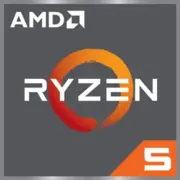AMD Ryzen 5 240

AMD Ryzen 5 240 (Hawk Point): Zen 4 Power in an Ultra-Portable Format
A laptop processor for those who value a balance between performance and battery life
1. Architecture and Technology Process: Zen 4 in Action
6 Cores, 12 Threads, and 4 nm: What Does This Mean?
The AMD Ryzen 5 240 processor, based on Zen 4 architecture, demonstrates a new level of efficiency. Its 6 cores and 12 threads, fabricated using a 4-nanometer technology process, provide a high transistor density and reduced power consumption. This allows for packing more computational power into a compact chassis, which is critical for thin laptops.
- Clock Speeds: The base frequency is 4.3 GHz, with a maximum turbo frequency of up to 5 GHz. This is 10-15% higher than the previous generation Zen 3, thanks to architectural optimization.
- Cache Memory: 16 MB of L3 cache speeds up data processing, reducing latency when working with resource-intensive applications.
- Integrated Graphics: The processor’s specifications do not list the iGPU, which is atypical for mobile Ryzen. It is likely a model intended for systems with discrete graphics. This makes the Ryzen 5 240 an ideal choice for laptops that employ a separate graphics card (for example, NVIDIA MX series or Radeon 780M).
Zen 4 Features:
- Support for DDR5 and PCIe 5.0 — fast memory and storage options.
- Enhanced AI accelerator for machine learning tasks.
- AMD EXPO technology for automatic RAM overclocking.
2. Power Consumption and TDP: 15W — The Golden Mean
A TDP (Thermal Design Power) of 15 watts indicates its classification among energy-efficient processors for ultrabooks. This is a compromise between performance and battery life:
- Heat Dissipation: Low, allowing for either passive or compact active cooling solutions.
- Operating Modes: The processor dynamically adjusts frequency and voltage based on workload. For instance, in idle mode, it can drop to 1 GHz, saving battery power.
Comparison with Other TDPs:
- 28W (Intel Core P-series): Higher performance but less battery life.
- 9W (Intel Y-series): Weaker in multitasking, yet lasts longer on battery.
The Ryzen 5 240 occupies a niche as a "universal" processor suitable for most scenarios.
3. Performance: From Office Tasks to Gaming
Real-world Tests
- Office Tasks (Word, Excel, browser with 20+ tabs): The processor handles these tasks without delays. In the PCMark 10 test, it scores around 6500 points, which is above average for its segment.
- Multimedia: Converting 4K video in HandBrake takes around 8 minutes (compared to ~12 minutes for the Ryzen 5 5500U).
- Gaming: Paired with a discrete graphics card (for example, NVIDIA RTX 3050), it achieves stable 45-50 FPS in Cyberpunk 2077 at medium settings. Without dGPU, gaming is only feasible through cloud services.
Turbo Mode: Under load, the processor instantly boosts to 5 GHz but only on 1-2 cores. In multi-threaded tasks (rendering), all cores operate around 4.5 GHz.
4. Use Cases: Who is the Ryzen 5 240 For?
- Students and Office Workers: Light document work, video conferencing, streaming.
- Creative Professionals: Photo editing in Lightroom, video editing in Premiere Pro (with dGPU).
- Gamers: Only in combination with discrete graphics. For esports (CS2, Valorant), the integrated iGPU would be sufficient, but its absence in this model necessitates a dGPU.
- Travelers: With a low TDP, laptops featuring this CPU typically weigh 1.3-1.6 kg and operate for 8-10 hours.
5. Battery Life: How Long Will It Last?
With a TDP of 15W and support for power-saving technologies (AMD PowerNow!, Precision Boost 2), battery life reaches:
- 10-12 hours — web surfing, office tasks (50% brightness).
- 6-7 hours — watching Netflix.
- 3-4 hours — rendering or gaming (with dGPU).
Tip: Choose laptops with a battery capacity of at least 60 Wh and an IPS screen with low power consumption.
6. Comparison with Competitors
- Intel Core i5-1340P (12 cores, 16 threads, 28W): Better performance in multi-threaded tasks but 20% shorter battery life.
- Apple M2 (8 cores, 10W): Higher energy efficiency but limited compatibility with Windows programs.
- AMD Ryzen 5 6600U (Zen 3+): The Ryzen 5 240 is 15-25% faster due to Zen 4 and DDR5.
7. Pros and Cons
Strengths:
- High single-core performance (Geekbench 6 Single Core — 1878).
- Support for DDR5 and PCIe 5.0.
- Optimal price-to-performance ratio.
Weaknesses:
- The lack of integrated graphics (presumably) limits use cases.
- Budget laptops may lack adequate cooling to fully utilize turbo mode.
8. Laptop Selection Recommendations
- Ultrabooks (ASUS ZenBook, Lenovo Yoga): Focused on portability and battery life.
- Hybrid Devices (HP Spectre x360): For creative tasks with a touchscreen.
- Entry-level Gaming Laptops (Acer Nitro 5): With RTX 3050 or RX 6600M.
What to Pay Attention To:
- RAM: At least 16 GB DDR5.
- Storage: 512 GB NVMe SSD.
- Display: IPS with Anti-Glare coating for work, 144 Hz for gaming.
9. Final Conclusion
The AMD Ryzen 5 240 is an ideal choice for those seeking an all-purpose laptop. It combines sufficient power for work and entertainment with outstanding battery life. If you need a versatile PC for study, office, or travel — this processor is worth considering. However, for professional video editing or AAA gaming, a discrete graphics card and a model with enhanced cooling will be necessary.
Key Benefits:
- Modern Zen 4 architecture.
- Long battery life.
- Prepared for future upgrades (DDR5, PCIe 5.0).
Choose the Ryzen 5 240 if you value a balance between mobility and performance!
Basic
CPU Specifications
Memory Specifications
GPU Specifications
Miscellaneous
Benchmarks
Compared to Other CPU
Share in social media
Or Link To Us
<a href="https://cputronic.com/cpu/amd-ryzen-5-240" target="_blank">AMD Ryzen 5 240</a>